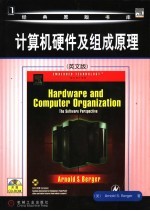

硬件及计算机组成原理 英文版PDF电子书下载
- 电子书积分:15 积分如何计算积分?
- 作 者:(美)伯杰(Berger,A.S.)著
- 出 版 社:北京:机械工业出版社
- 出版年份:2006
- ISBN:7111174720
- 页数:492 页
CHAPTER 1:Introduction and Overview of Hardware Architecture 1
Introduction 1
A Brief History of Computing 1
Contents 7
Preface 7
Acknowledgments 12
Number Systems 12
What's on the DVD-ROM? 13
Converting Decimals to Bases 25
Engineering Notation 26
Summary of Chapter 1 27
Exercises for Chapter 1 28
CHAPTER 2:Introduction to Digital Logic 29
Electronic Gate Description 39
Truth Tables 44
Summary of Chapter 2 46
Exercises for Chapter 2 47
CHAPTER 3:Introduction to Asynchronous Logic 49
Introduction 49
Laws of Boolean Algebra 51
The Karnaugh Map 55
Clocks and Pulses 62
Summary of Chapter 3 67
Exercises for Chapter 3 68
CHAPTER 4:Introduction to Synchronous Logic 71
Flip-Flops 72
Storage Register 83
Summary of Chapter 4 90
Exercises for Chapter 4 91
CHAPTER 5:Introduction to State Machines 95
Modern Hardware Design Methodologies 115
Summary of Chapter 5 119
Exercises for Chapter 5 120
Bus Organization 123
CHAPTER 6:Bus Organization and Memory Design 123
Address Space 136
Direct Memory Access(DMA) 152
Summary of Chapter 6 153
Exercises for Chapter 6 155
CHAPTER 7:Memory Organization and Assembly Language Programming 159
Introduction 159
Label 170
Effective Addresses 174
Pseudo Opcodes 183
Data Storage Directives 184
Analysis of an Assembly Language Program 186
Summary of Chapter 7 188
Exercises for Chapter 7 189
CHAPTER 8:Programming in Assembly Language 193
Introduction 193
Assembly Language and C++ 209
Stacks and Subroutines 216
Summary of Chapter 8 222
Exercises for Chapter 8 223
CHAPTER 9:Advanced Assembly Language Programming Concepts 229
Introduction 229
Advanced Addressing Modes 230
68000 Instructions 232
MOVE Instructions 233
Logical Instructions 233
Other Logical Instructions 234
Summary of the 68K Instructions 238
Simulated VO Using the TRAP #15 Instruction 240
Compilers and Assemblers 242
Summary of Chapter 9 259
Exercises for Chapter 9 260
CHAPTER 10:The Intel x86 Architecture 265
Introduction 265
The Architecture of the 8086 CPU 267
Data,Index and Pointer Registers 269
Flag Registers 272
Segment Registers 273
Instruction Pointer(IP) 273
Memory Addressing Modes 275
X86 Instruction Format 278
8086 Instruction Set Summary 282
Data Transfer Instructions 282
Arithmetic Instructions 283
Logic Instructions 284
String Manipulation 285
Control Transfer 286
Assembly Language Programming the 8086 Architecture 289
System Vectors 291
System Startup 292
Wrap-Up 292
Summary of Chapter 10 292
Exercises for Chapter 10 294
CHAPTER 11:The ARM Architecture 295
Introduction 295
ARM Architecture 296
Conditional Execution 301
Barrel Shifter 302
Operand Size 303
Addressing Modes 304
Stack Operations 306
ARM Instruction Set 309
ARM System Vectors 319
Summary and Conclusions 320
Summary of Chapter 11 320
Exercises for Chapter 11 321
CHAPTER 12:Interfacing with the Real World 322
Introduction 322
Interrupts 323
Motorola 68K Interrupts 327
Exceptions 327
Analog-to-Digital(A/D)and Digital-to-Analog(D/A)Conversion 332
The Resolution of A/D and D/A Converters 346
Summary of Chapter 12 348
Exercises for Chapter 12 349
CHAPTER 13:Introduction to Modern Computer Architectures 353
Processor Architectures,CISC,RISC and DSP 354
An Overview of Pipelining 358
Summary of Chapter 13 369
Exercises for Chapter 13 370
CHAPTER 14:Memory Revisited,Caches and Virtual Memory 372
Introduction to Caches 372
Virtual Memory 387
Pages 389
Translation Lookaside Buffer(TLB) 391
Protection 392
Summary of Chapter 14 393
Exercises for Chapter 14 395
CHAPTER 15:Performance Issues in Computer Architecture 397
Introduction 397
Hardware and Performance 398
Best Practices 414
Summary of Chapter 15 416
Exercises for Chapter 15 417
CHAPTER 16:Future Trends and Reconfigurable Hardware 419
Introduction 419
Reconfigurable Hardware 419
Molecular Computing 430
Local clocks 432
Summary of Chapter 16 434
Exercises for Chapter 16 436
APPENDlX A:Solutions for Odd-Numbered Exercises 437
About the Author 483
Index 485
- 《计算机网络与通信基础》谢雨飞,田启川编著 2019
- 《大学计算机实验指导及习题解答》曹成志,宋长龙 2019
- 《卓有成效的管理者 中英文双语版》(美)彼得·德鲁克许是祥译;那国毅审校 2019
- 《计算机辅助平面设计》吴轶博主编 2019
- 《计算机组成原理解题参考 第7版》张基温 2017
- 《第一性原理方法及应用》李青坤著 2019
- 《云计算节能与资源调度》彭俊杰主编 2019
- 《Helmholtz方程的步进计算方法研究》李鹏著 2019
- 《高等院校保险学专业系列教材 保险学原理与实务》林佳依责任编辑;(中国)牟晓伟,李彤宇 2019
- 《AutoCAD 2018自学视频教程 标准版 中文版》CAD/CAM/CAE技术联盟 2019
- 《指向核心素养 北京十一学校名师教学设计 英语 七年级 上 配人教版》周志英总主编 2019
- 《北京生态环境保护》《北京环境保护丛书》编委会编著 2018
- 《高等教育双机械基础课程系列教材 高等学校教材 机械设计课程设计手册 第5版》吴宗泽,罗圣国,高志,李威 2018
- 《指向核心素养 北京十一学校名师教学设计 英语 九年级 上 配人教版》周志英总主编 2019
- 《高等院校旅游专业系列教材 旅游企业岗位培训系列教材 新编北京导游英语》杨昆,鄢莉,谭明华 2019
- 《中国十大出版家》王震,贺越明著 1991
- 《近代民营出版机构的英语函授教育 以“商务、中华、开明”函授学校为个案 1915年-1946年版》丁伟 2017
- 《新工业时代 世界级工业家张毓强和他的“新石头记”》秦朔 2019
- 《智能制造高技能人才培养规划丛书 ABB工业机器人虚拟仿真教程》(中国)工控帮教研组 2019
- 《AutoCAD机械设计实例精解 2019中文版》北京兆迪科技有限公司编著 2019
